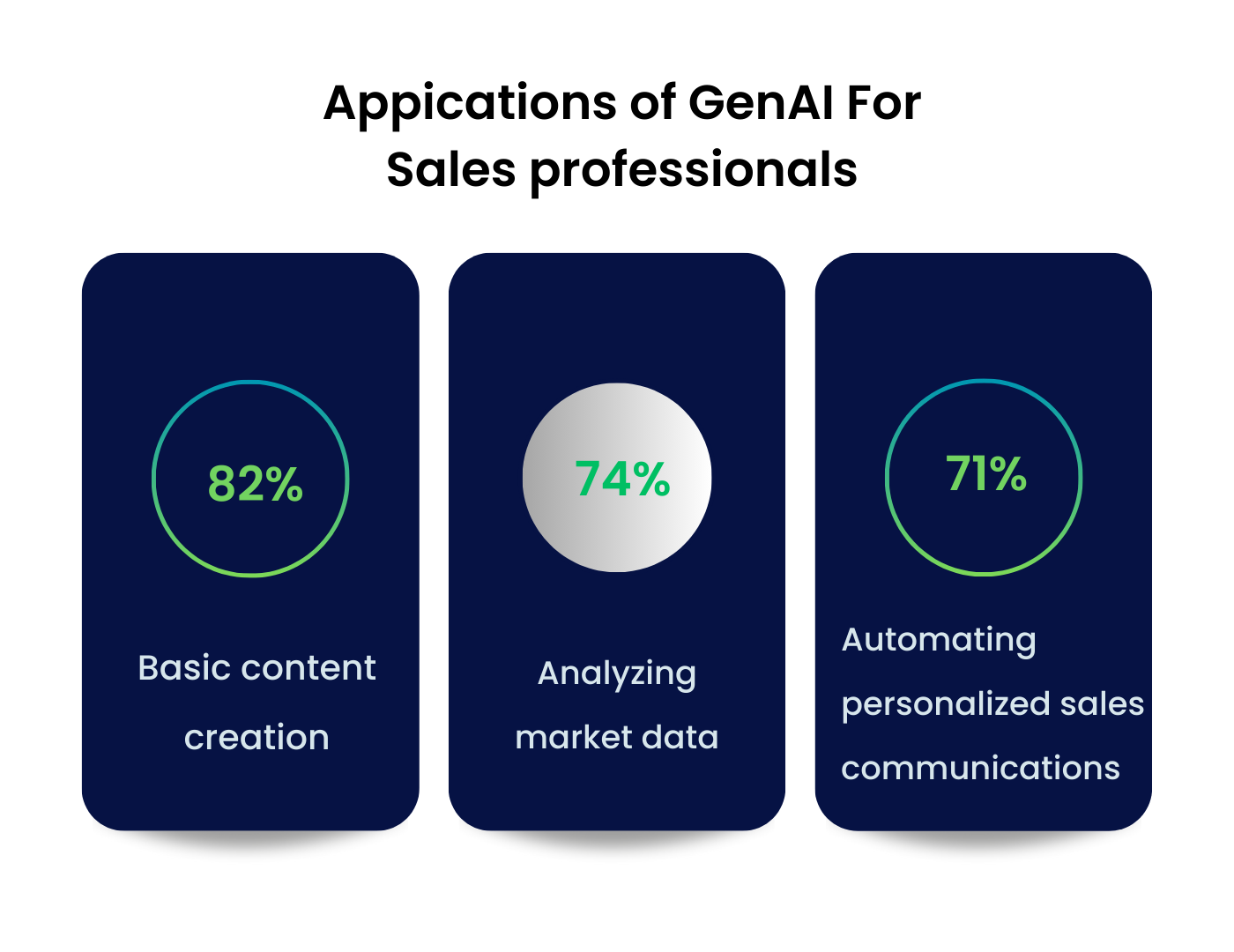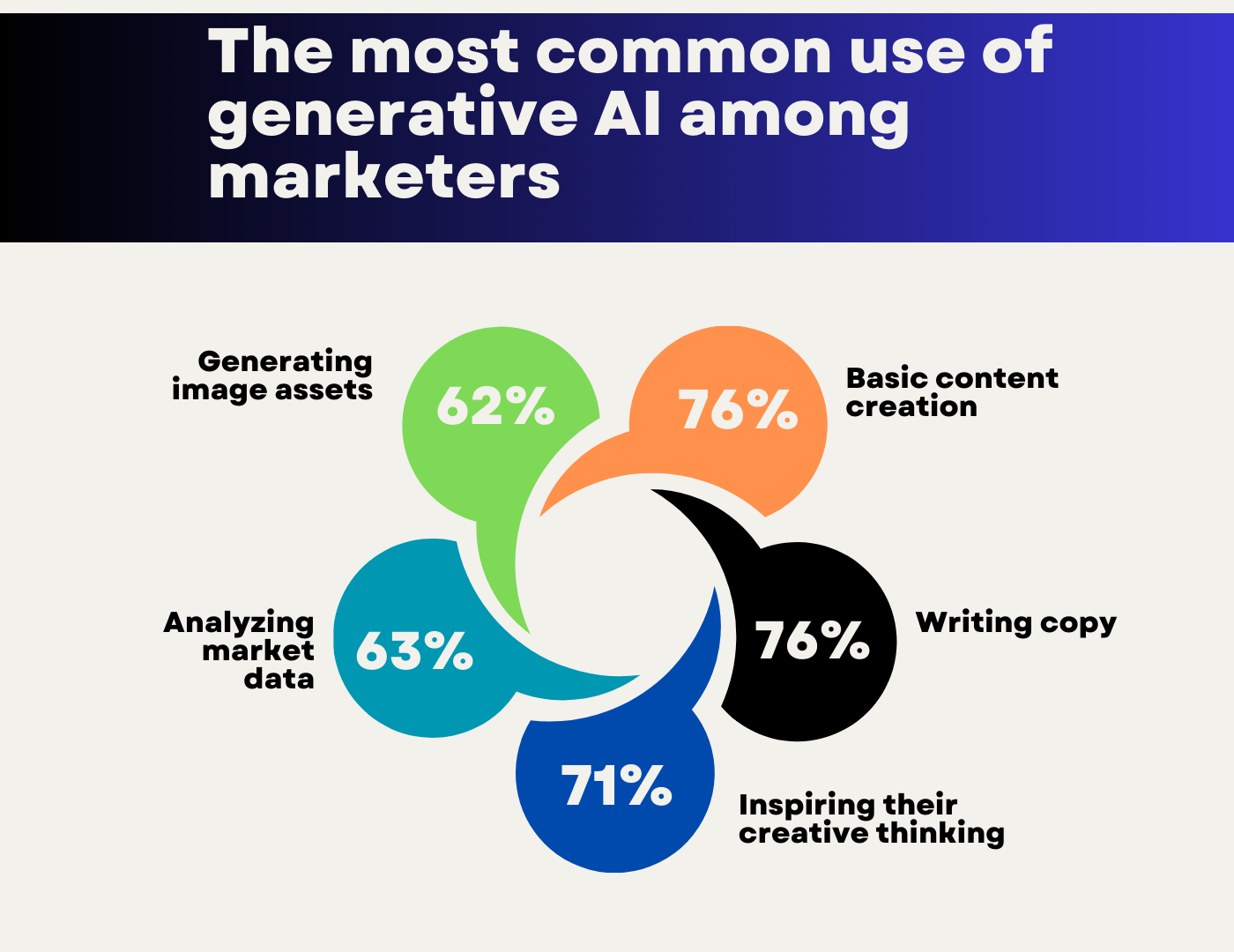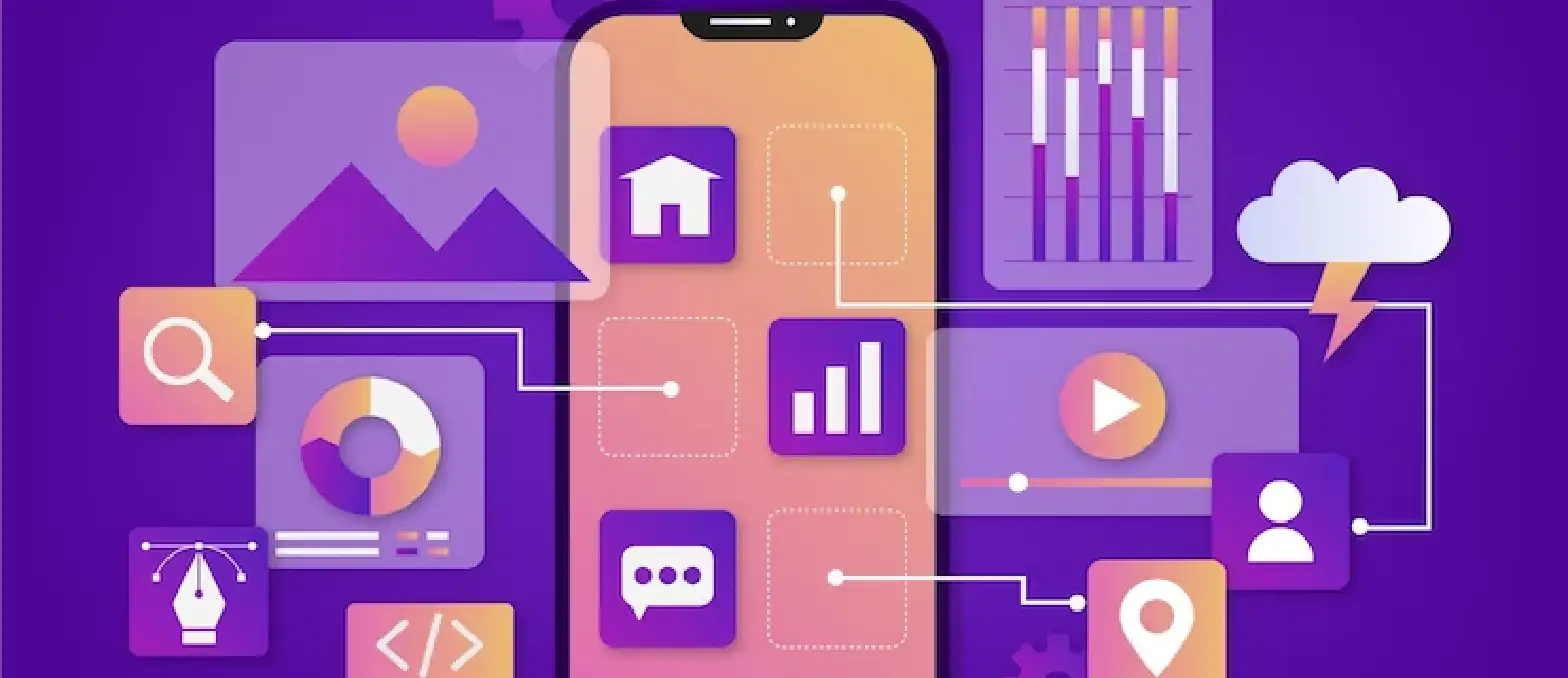Table of Contents
The advancements in machine learning technology have had a significant impact on the sales sector in recent years. AI has revolutionized lead generation and client relationship management, among other areas of sales. However, generative AI is one particular subset of AI that could have a big influence on sales strategy. A centralized “GenAI Operations” team will be staffed by 35% of chief revenue officers by 2025 as a component of their go-to-market group. Sales enablement leaders can encourage ethical technology use as adoption picks up speed to improve sales results. Creating enablement programs based on use cases pertinent to sellers’ roles as revenue generators will be a critical success factor.
Overview
Computers can now create original text, photos, and videos thanks to a sort of machine learning called generative AI. Generative AI in sales can generate tailored information for clients, including product recommendations or promotional materials. This can facilitate more effective communication between sales teams and clients, enabling them to offer customized solutions that address their unique requirements.
All things considered, the development of Generative AI has the potential to completely change how salespeople approach their business and engage with clients. The advances in artificial intelligence technology and machine learning solutions have brought about a substantial revolution in the sales business in recent years. AI development has completely changed several sales-related processes, including customer relationship management and lead generation. Generative AI is one area of AI that has enormous potential for sales strategy.

The Rise of Generative AI Technology
Deep learning technology that can “learn” to produce statistically likely outputs when given instructions is referred to as generative AI development. In essence, Generative AI development company take their training data and encode a simplified representation of it, using that information to generate new work that is somewhat similar to the original data but not the same.
In statistics, generative models have long been used to evaluate numerical data. However, the development of deep learning technology allowed them to be applied to voice, pictures, and other complicated data types.
Variational Autoencoders
Variational autoencoders, or VAEs, were among the first class of models to accomplish this crossover achievement. They were originally introduced in 2013. Unlabeled data is first encoded into a compressed representation using autoencoders, which subsequently decode the data back into its original format. One of the many uses for “plain” autoencoders was the reconstruction of distorted or fuzzy images. The crucial capability of variational autoencoders was added. They could produce variations on the original data in addition to reconstructing it.
This capacity to produce new data sparked an explosive development in the field. It leads tothe development of ever more realistic but fake image-producing systems such as diffusion models and generative adversarial networks (GANs).
VAEs paved the path for the generative AI technology of today. They are constructed using blocks of encoders and decoders, the same architecture that supports the massive language models of today.
- Encoders group related data points closer together in an abstract space to compress a dataset into a dense representation.
- The key characteristics of the dataset are preserved while new content is created by decoders using samples from this area.
The Age of Transformers
Transformers changed the way language models were trained by combining the encoder-decoder architecture with a text-processing technique termed attention. Transformers were first presented by Google 2017 a leading artificial intelligence development company in a seminal paper titled “Attention Is All You Need.” Raw, unannotated text is transformed into representations called embeddings by an encoder; the decoder uses these embeddings along with earlier model outputs to predict words in sentences one after the other.
- Using fill-in-the-blank guessing games, the encoder gains an understanding of the relationships between words and sentences, constructing a robust representation of language without the need for human annotation of grammatical aspects and components of speech.
- Transformers can be pre-trained without having a specific mission in mind right away. After learning these strong representations, the models can be later trained to do a specific task with considerably less data. This was made feasible by several breakthroughs.
- Transformers accelerated training by processing a sentence’s worth of words at once and enabling simultaneous text processing. Words were processed one at a time using earlier methods such as recurrent neural networks (RNNs) and long short-term memory (LSTM) networks.
- Transformers also picked up on word placements and their connections, as well as context, which helped them decipher lengthy phrases and determine the meaning of words like “it.”
- Transformers made it feasible for generative AI development services to pre-train language models on large volumes of unprocessed text, removing the requirement to define a goal in advance and enabling them to expand substantially in size. Before, data was collected and tagged to train a single model for a particular task.
These days, Large Language Model Development is utilized not only for generative tasks like translation, summarization, and question-answering but also for non-generative activities like entity extraction and categorization. Transformers have recently astounded the world with their ability to produce believable essays, dialogue, and other content.
There are 3 types of Large Language Models:
| Model Type | Examples | Description |
|---|---|---|
| Encoder-only models | BERT, IBM’s Watson Assistant | Used in tasks such as search engines, customer-service chatbots, and information extraction. Widely employed for non-generative tasks like classifying customer feedback. |
| Decoder-only models | GPT (including GPT-3), Google’s PaLM, BLOOM | Trained to predict the next word without an encoded representation. Typically utilized for generative tasks. |
| Encoder-decoder models | Google’s Text-to-Text Transfer Transformer (T5) | Combine features of both BERT and GPT-style models. Capable of generative tasks like decoder-only models but are more compact, making them faster and cheaper to tune and serve. |
Streamline Operations and Drive Revenue Growth with Our Generative AI Development Services
GenAI in Sales: Significance
Reducing the growth of administrative complexity
The steady rise in administrative work that comes with being in sales is a burden that almost every sales company we work with faces. The complexity of selling increases along with the requirement for paperwork, permissions, and compliance reporting. Unintentionally, a significant contributing aspect is the growing usage of sales technology. More data entry, training, and report reading are frequent consequences of new technologies. For instance, salespeople can use Generative AI to generate emails, reply to proposal requests, arrange notes, and automatically update CRM data, therefore, reversing administrative creep.
Improving the way salespeople deal with customers.
Generative AI in industries, especially sales, has been developing recently. Numerous businesses are implementing AI-driven platforms that suggest tailored offers and information for consumers, as well as the most effective channel for sales representatives to communicate with them. Recommendations are derived from information regarding the customer’s past interactions, similar customers’ interests and activities, and other relevant data. To enhance the algorithms, salespeople have the option to accept or reject the recommendations and grade their quality.
The models can generate more accurate recommendations by adding Generative AI in Sales. One instance would be taking into account consumer opinions as shown by the finer points of language and subliminal cues of interest or mistrust found in emails, chats with salespeople, posts on social media, and other sources. Additionally, the salesman and the system can work together to enhance recommendations in real time. For instance, a salesperson can delve further after being advised to approach a customer with a new offering. They can do this by looking both vertically into the customer’s demands and horizontally to identify other consumers who would find value in the same offering. The application is user-friendly because of its conversational, interactive user interface. In a genuine seller-buyer dialogue, the buyer is also able to participate.
Helping sales supervisors
Analysis of sales performance reports and analytics takes up a lot of time for sales managers. The majority of sales reports have evolved recently from being passive, retrospective papers to becoming more interactive diagnostic tools with drill-down capabilities. Generative AI in Sales can enhance the strength and forward-thinkingness of reporting systems. To help salespeople develop better and to provide more focused and inspiring coaching feedback, managers can ask questions to gain insights. Weeks-long sales planning chores can now be completed in an hour as managers engage with the system to identify possibilities, develop important account strategies, and decide how best to distribute resources among geographies, customers, products, and activities.
Sales Forecasting
Although a lot of sales managers base their estimates on best practices, it’s common for them to predict the pipeline incorrectly. Just 43% of sales executives claim to consistently forecast with an accuracy of 10% or less, according to Forrester. Generative AI development services can significantly reduce these forecasting errors.
Recall that predictions rank as the most valuable sales analytics data insight for more than 50% of salespeople. Sales planning enhancement is by the combination of Al with sales because of the AI’s capabilities to forecast. Generative AI in Sales gives sales firms a tactical edge when allocating resources and making decisions. Imagine, for example, that Al uses consumer data analysis to forecast purchasing trends, which helps with targeted advertising and better inventory control.
By utilizing years’ worth of data, Generative AI in Sales systems can precisely foresee and predict future sales patterns by utilizing vast amounts of historical data. Typical Al-driven sales forecasts include the following:
- New opportunities or possible clients
- Potential closure of deals or prospects
- Potentially closed transactions or prospects shortly (next target prospects)
Generative AI companies for sales can forecast who is most likely to purchase in the future by combining historical and present data. Furthermore, to forecast future sales trends, generative AI for sales makes use of market trends, seasonality, and economic data. Better still, AI systems can spot correlations and patterns that could escape human notice. Generative AI in Sales forecasts demand accurately in the future.
Lead Scoring and prioritization
Sales teams may now focus their efforts and resources on the most promising leads thanks to artificial intelligence. Al and machine learning services-driven intelligence are used to evaluate and rank leads in this process. In AI-driven lead scoring, data analysis includes:
- Details on the demographics
- Online purchasing habits
- Levels of engagement
- Past sales information
AI’s ability to analyze enormous amounts of data and find hidden patterns is what makes it so beautiful. Generative AI may find, for instance, that leads who interact with emails, visit particular pages, and fit particular demographic profiles have a higher likelihood of becoming paying clients. The sales staff may concentrate their efforts on these high-potential leads thanks to this understanding.
AI can follow a lead’s activities as they engage with your business’s digital touchpoints, such as website visits and app usage, and recognize important signals that indicate sincere interest. AI and machine learning solutions also improve its grading system over time by learning from past data. This improves its forecasting accuracy for successful conversions. Essentially, artificial intelligence (AI) turns lead assessment into a more streamlined, data-driven procedure. Improved overall sales performance, higher conversion rates, and increased efficiency are the outcomes.

GenAI in Sales – Use Cases
Generating Content for Promotional Materials
Case studies, whitepapers, social media updates, and blog pieces with SEO optimization are just a few of the AI in marketing initiatives that AI-generated sales material may help with. Sales teams can successfully draw in, interact with, and nurture prospects down the sales funnel by producing high-quality, scale-targeted content.
Using ChatGPT and other generative AI technology, sales enablement materials like these can be made:
- Brochures
- Sales scripts
- Sales manuals
Integration with CRM systems
CRM systems usually hold a plethora of data in the form of email correspondence, social media remarks, support requests, and client interactions. Since a large portion of this data is unstructured, conventional analytics tools have a hard time drawing insightful conclusions from it.
Using machine learning and natural language processing solutions, generative AI may examine this unstructured data to find patterns, client demands, and sentiment. For example, unstructured data analysis might highlight common consumer complaints, allowing companies to proactively address these issues and raise customer happiness.
Use AI to personalize sales outreach like emails
Utilize AI to highlight pertinent case studies, current happenings, relationships with current clients, pertinent legislation, etc. This is to better personalize outreach mailings using sales intelligence data. OpenAI’s ChatGPT has already been used to develop an assistant that can accomplish this on a large scale. It will generate a customized opener (such as congratulating on a recent funding series) based on analysis of contact signals, such as pertinent news stories.
It will even automatically evaluate responses to determine the objection type and the best response, making the follow-up sequence far more interesting. The next step in the development of generative AI automation is the capacity to have conversations.
Use prescriptive analytics driven by AI to improve your approach and workflow.
However, AI is more than just a tool to help your sales representatives make smarter judgments on the fly. A generative AI company can also support your company in making important strategic decisions. It is no longer necessary to hire highly compensated analysts to go through data, make personalized reports, and look for important insights that are hidden in plain sight. Prescriptive analytics driven by generative AI, on the other hand, can locate these crucial insights for you.
Your team needs prescriptive analytics to assist them target the right people inside the company and optimize their overall selling strategy. It’s the logical progression from AI sales forecasting to advising on how to close transactions, rather than just estimating their value.
Sentiment analysis
Generative AI services are capable of analyzing social media comments, reviews, and consumer feedback to determine sentiment and spot any problems or possibilities. Sales teams can use this information to better handle customer complaints, and capitalize on positive comments. They craft sales pitches that appeal to their target market.
Sales automation and training
Automating tedious processes is one of generative AI’s greatest advantages in sales. Salespeople, for instance, frequently invest a lot of time in producing email templates, proposals, and other sales materials. Generative AI services can produce these materials rapidly and effectively, giving salespeople more time to concentrate on other facets of their work, like cultivating client connections.
Generative AI produces
-Customized training materials
-role-play scenarios and
-simulations
These cater to the particular needs and challenges of every sales team in the sales process. Sales professionals can perform better and have higher success rates in a sales process by using AI and machine learning-driven sales training to hone their abilities, increase their product knowledge, and strengthen their ability to handle client objections.
Enhance Customer Engagement by Using Generative AI in Sales Processes
Best AI tools for Sales & Marketing
HubSpot – ChatSpot
The result of the collaboration between OpenAI’s ChatGPT Gen AI with HubSpot CRM is ChatSpot, a conversational AI platform that makes use of natural language processing to comprehend and reply to user inquiries. ChatSpot uses HubSpot’s CRM platform to improve firms’ sales and marketing operations by utilizing OpenAI’s database, ChatGPT Gen AI, and Dall-E.
For example, ChatSpot lets you search your database according to particular parameters like size, region, or revenue. This makes it simple for you to see a high-level perspective of your most pertinent leads.
You may use these generative AI tools to develop buyer personas, blog post titles, LinkedIn articles, email subject lines, and sales emails in addition to CRM questions. Additionally, its Dall-E integration produces photos for social media, websites, and other platforms.
Zia Zoho
Zoho Zia is a Generative AI helper that streamlines work across multiple Zoho apps and offers wise guidance. Numerous Zoho products, including Zoho CRM, Zoho Analytics, Zoho Desk, and Zoho SalesIQ, contain Zia.
Zia can comprehend and analyze user inquiries, gather data, produce insights, and support decision-making. By providing individual recommendations, analytics, and predictive insights based on the data accessible within Zoho applications, it is intended to increase productivity and improve user experience.
The capacity of Zoho Zia to evaluate data and offer conclusions and suggestions makes it stand out. It can use a variety of mathematical models to create projections, look for correlations, and analyze trends and patterns in data. This prediction capacity is among the most important features of AI that exists today.
SaneBox
SaneBox sales teams frequently receive hundreds of emails every day, making it difficult to sort through and prioritize critical emails from spam or unrelated ones. Introducing Sanebox, a generative AI email management application that helps you sort and prioritize emails.
Sanebox evaluates sender behavior, content, and email patterns using machine learning algorithms to assess the significance of each email. You can prioritize the most important emails by having SaneLater, SaneNews, SaneDigest, SaneNoReplies, SaneNotSpam, SaneBlackHole, and SaneReminders filter away low-priority or unnecessary emails into a different folder.
Its integration can be with several email clients, including Windows, Mac OS, iOS, Android, AOL, Gmail, Yahoo, Outlook, and Apple Mail.
ActiveCampaign
CRM features, marketing automation, and email marketing are all combined in ActiveCampaign. By offering insights, streamlining processes, and sending tailored messaging, it supports sales teams in efficiently nurturing and converting leads. With the help of capabilities like email segmentation, lead scoring, predictive sending, and behavioral analytics, sales teams can tailor interactions and provide leads with dynamic content thanks to ActiveCampaign.
With ActiveCampaign, companies can increase client engagement and conversions by automating communication via SMS, social media, email, and other channels.
ActiveCampaign is suitable for multichannel automation, a feature that is crucial for today’s sales teams because it can integrate so many different operations into a single solution.
Pipedrive
As an automated sales expert, Pipedrive’s sales assistant assists sales teams in evaluating their historical sales data, making suggestions, and enhancing sales to increase profits. Pipedrive helps you track leads, identify opportunities, and measure important activities. It does this by offering lead and deal management, contact and company information tracking, sales forecasting, analytics, and reporting.
Pipedrive may operate as an AI-based sales controlling and tracking system because of its extensive range of integrated tracking and sales help functions.
In comparison to rivals like ActiveCampaign and HubSpot, it is more affordable for SMBs searching for low-cost AI-powered sales tools. Pipedrive offers five subscription levels that cater to different business sizes and offer a range of features and price alternatives.
Apollo AI
Apollo is an AI intelligence tool that has over 275 million leads in its B2B database. It enables you to identify the best-qualified prospects for your company by drilling down into particular parameters using 65 data elements. Its AI-driven engine creates highly focused business leads, tracks and analyzes the online activity of potential prospects, and assists in prospect identification.
Built on Apollo’s database of 275 million contacts, the GPT model from OpenAI powers the assistant tool Apollo AI. You can utilize it to build highly customized emails and program follow-ups according to the actions of potential customers. With the help of Apollo.io’s multi-channel support, sales teams may communicate with prospects via phone, email, and social media.
SeamIess.ai
Similar to Apollo AI, Seamless.ai provides real-time access to contact information, business intelligence, and sales insights. It acts as a sales enablement and lead-generating tool. To assist you in finding the contact information of leads, it provides a comprehensive database of contacts and firm details.
Salespeople may create focused prospect lists, locate contact details, and interact with possible clients with Seamless.ai. Its Artificial intelligence service helps users focus on the correct prospects and increase their conversion rates by giving them verified and accurate data. Because of its capacity to leverage AI for targeting, Seamless is a viable option for companies looking to support their business development teams.
Conclusion
Generative AI in Sales, to put it simply, is an enhancement force rather than a replacement. Sales have a chance to advance to new heights of efficiency and sophistication because of AI. Though there is discussion of AI replacing humans, the truth is more nuanced with this rise. AI and humans both work together to improve the sales process. AI speeds up decision-making, automates tasks, and analyzes data to provide insights.
Stated differently, Al performs things that human sales representatives are unable or too busy to complete manually. Indeed, human intervention and abilities such as understanding and empathy are still essential. Salespeople listen, interpret cues, and customize solutions. AI frees salesmen from routine tasks so they can concentrate on building relationships. Salespeople cultivate relationships and plan, while AI and ML manage data. Top machine-learning companies generally give salespeople more leverage by utilizing technology to improve the human element.
Make Your Sales More Impactful, Productive, and Successful With Our Generative AI Solutions
How A3Logics Help to Leverage Gen AI?
AI revolutionizes sales strategy through automation and data analysis. It makes customized recommendations, ranks leads according to priority, and forecasts trends. There has never been a better moment for sales leaders to use AI tools to boost productivity and produce more accurate projections.
With A3Logics one of the Best AI solution providers in the USA, you can unleash the potential of AI and ML-powered sales tactics. Your sales process can be completely transformed using AI solutions from a top artificial intelligence solutions company. You’ll learn how AI tools can improve your customer relationship management and your team’s capabilities.
FAQ
Which sales applications use artificial intelligence?
AI is useful for B2B sales cycles in several ways. It can automate lead engagement, follow-ups, and initial contact with prospective customers. With the capacity to manage several conversations at once and personalize targeted outreach, advanced AI sales technologies like NLP services and generative AI can offer a deeper understanding of client inquiries.
What advantages come with applying AI techniques to sales?
The potential of artificial intelligence (AI) to automatically improve sales performance and results through content and data analysis. Using AI techniques, sales teams can:
- Save time, increase win rates, and visibility into the pipeline.
- Improve your interactions with potential clients and consumers.
- Expand via mechanizing labor-intensive processes
What is the future of AI in Sales?
GenAI has the potential to completely change the sales organization. The emerging use of generative AI for data management, automation design, and technology administration is augmented reconfiguration operations (RevOps). AI-generated training facilities for sales education and development represent yet another fascinating application case.






